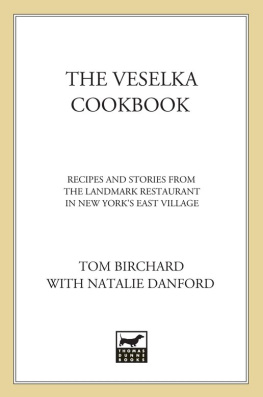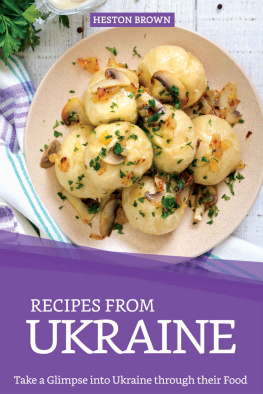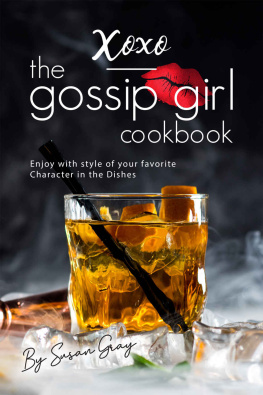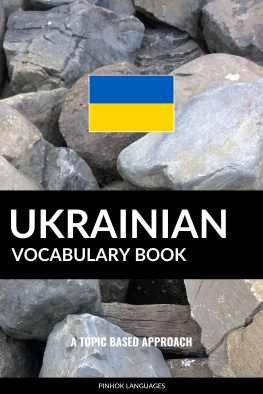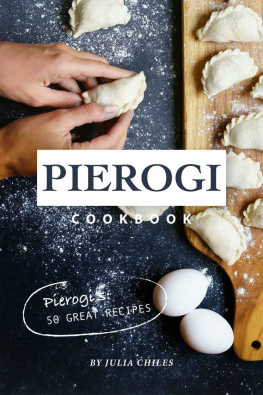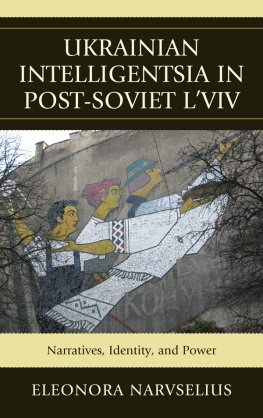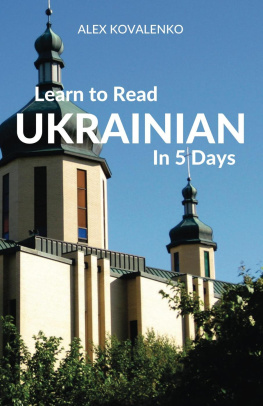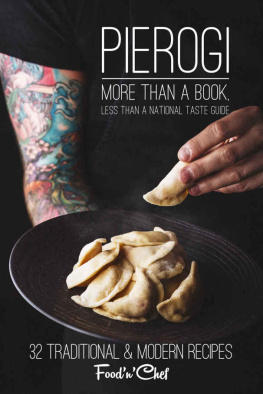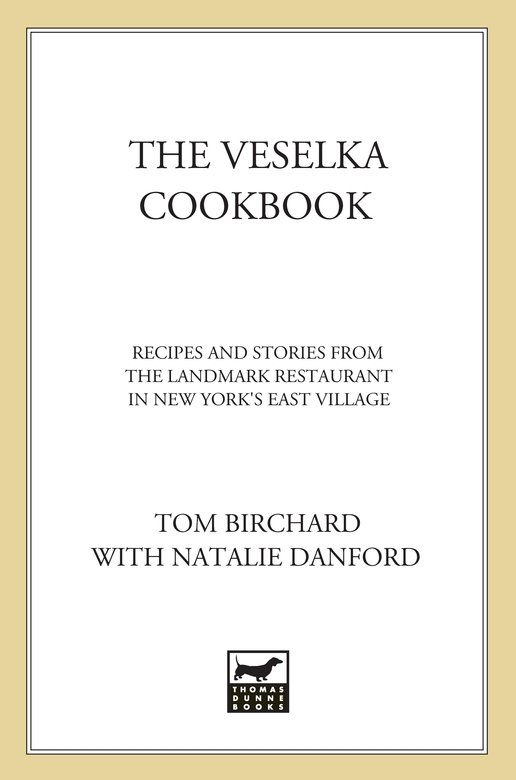First of all, Id like to thank my collaborator, Natalie Danford, without whose help this book would not have been possible. Natalie was able magically to absorb the culture and cuisine of Veselka and put it into words more eloquently than I would have been able. Working with her was a total pleasure and I am forever grateful for all of her help.
Id like to thank Lisa Straub, Veselkas pastry chef, who not only wrote up her own recipes for the many baked items she creates for Veselka but was instrumental in collecting all the recipes in this book, the vast majority of which appear here in written form for the first time. Lisa did an incredible job of making a pinch of this and a pinch of that concrete, and she handled much of the grunt work. I dont think I can overstate what a big help she was. My thanks, also, to Lucy Baker, who tested every recipe in this book, many of them twice and some three times, and patiently went over any adjustments and came up with her own suggestions for giving home cooks the tools for making the most Veselka-like dishes possible in their own kitchens.
Thanks, also, to editor Diana Szu, who gave this project a great deal of attention and unflagging enthusiasm. It feels almost strange to thank Angela Miller for serving as my agent on this book, as shes also a friend. Our casual meeting on a Vermont bike ride several years ago has proven extremely fortuitous. Im so glad that she came up with the idea of a Veselka cookbook and encouraged me to do it. Nadea Mina contributed great ideas and thoughtful suggestions from the publicity end, and copy editor Leah Stewart cleaned it all up and made me look smart. My thanks to everyone at Thomas Dunne Books/St. Martins Press for their hard work.
Of course, I am eternally grateful to the late Wolodymyr Darmochwal, the original owner of Veselka, for letting me work there and for founding such a unique restaurant. Im very indebted to my son Jason Birchard, the next generation at Veselka and the third generation of the Darmochwal family to run the restaurant, and to Mykola and Zoriana Darmochwal, for working with me and maintaining the family connection and for their contributions to this book and especially their expertise on Ukrainian traditions and home cooking. Jason began working at Veselka when he was only fourteen years old and has been putting his heart and soul into it ever since. Im grateful to everyone who has been a part of the dedicated Veselka staff over the last fifty-five years. Id especially like to acknowledge cooks Aleksandra Grabska and Malgorzata Sibilska, who have worked with me for well over twenty years and are the backbone of the Veselka kitchen, as well as Gerhard Waldman, who recently retired after serving ably as Veselkas manager for many years. Ive also enjoyed working with Julian Baczynsky for more than thirty years as he has supplied us with kielbasa and contributed in so many other ways to Veselka.
Id also like to thank all the people who were interviewed for this book and graciously gave their time and energy to the project. Im amazed, time and time again, at how personally connected everyone seems to feel to Veselka. Many thanks to Julian Baczynsky (again), Mort Zachter, Andy Lastowecky, Dona McAdams, Mark Russell, Penny Arcade, Tim Miller, and Arnie Charnick.
Bokek Ryzinski designed and built the current incarnation of Veselka and did a wonderful job of keeping the feel of the original while also updating the physical space. William Hellow has been Veselkas graphic designer since 1996 and not only designed our menus but is a true renaissance man with an extraordinary eye who has helped with lighting design and many other visual aspects of the restaurant. Ben Fink contributed most of the beautiful photographs in this book, and Petro R. Stawnychy, chair of Plasts National Executive Board, kindly allowed us to use the groups logo.
Finally, Im so lucky to have a family that supports me, including not only Jason, who works side-by-side with me, but also my son Tom Jr., his wife, Sonja, and their children, Tyler and Serena (my beautiful grandchildren), and my children Kristen, Todd, and Sara. My wonderful wife Sallys unconditional love gives me so much strength and comfort that all things seem possible.
The recipes that are included book can be found on the page numbers in parentheses following the recipe title.
THANKSGIVING
roasted turkey
roasted Brussels sprouts
EASTER
Borscht or Vegetarian Borscht
sauted spinach
MOTHERS DAY BRUNCH
Raspberry Blintzes
punch made with half sparkling water and
half fruit juice
FATHERS DAY DINNER
BIRTHDAY DINNER
tossed green salad
SUMMER COOKOUT
lemonade
UKRAINIAN INDEPENDENCE DAY
(AUGUST 24)
BUFFET BRUNCH
PICNIC LUNCH
, cut into small squares
BOX LUNCH
carrot and celery sticks
HOME WITH A COLD LUNCH
hot tea with lemon and honey
SUNDAY SUPPER
braised carrots
WEEKNIGHT DINNER
SUPERBOWL PARTY
Allspice berries can be purchased whole or ground. They are the unripe berries of a tropical tree.
Aspic is a savory jelly, usually made with stock and gelatin and always served chilled.
Bagels were initially a Jewish food, but they have become one of the emblematic foods of New York City. They are dense, chewy rings of bread that are boiled quickly before they are baked.
Barley, a very digestible grain, is often used in soup and also to make beer.
Bigos is a meat and cabbage stew that is cooked long and slow. It is eaten throughout Eastern Europe, but is most strongly connected with Poland.
Blintzes are thin pancakes similar to crepes. They are often filled with farmers cheese and sometimes topped with fruit.
Borscht is an Eastern European soup that usually contains beets in some form or another. It may be served hot or cold.
Buckwheat flour is ground from buckwheat, which is not, as often assumed, a kind of grain but is instead a grass.
Cake flour is made from softer wheat than all-purpose flour. It gives cakes and other baked goods a very tender crumb.
Cardamom is made by grinding the seeds of a plant in the ginger family.
Challah is a leavened egg bread of Jewish origin. For religious purposes, challah is formed into a braid and then baked for the Sabbath. At Veselka we shape our nondenominational bread into a Pullman loaf for sandwiches.
Ciabatta is the Italian word for slipper, but it also refers to a kind of white bread with a lot of holes in the crumb. At Veselka, we use ciabatta rolls for several of our sandwiches.
Cumin is sold ground or in whole seeds. It is derived from a plant similar to parsley.
Durum flour is made from durum wheat, which is harder (i.e., has a higher protein content) than the wheat used to make all-purpose flour. Durum flour, sometimes called semolina flour, is used to make pasta.

